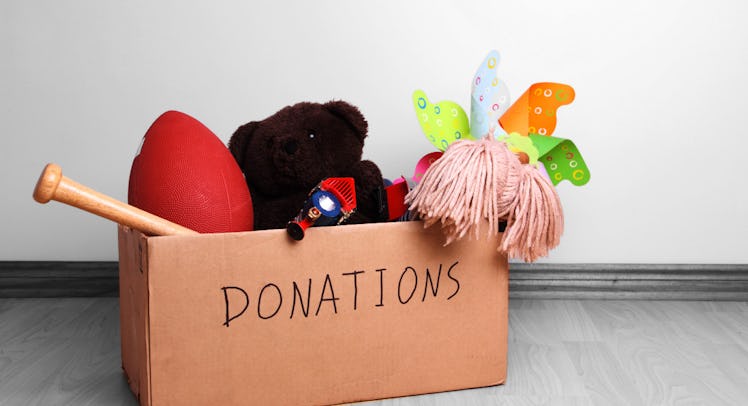How to Get Rid of Kid’s Toys Without Tears
When parents want to downsize the toy box, it can lead to tantrums and conflict. A little planning helps.

Kids are magnets for material goods. The calendar year is chock-full of occasions for children to fill up the toy box with gifts and favors that slowly overwhelm toy storage strategies, threatening to bury a home with noisy, brightly-colored, plastic stuff. But, should a parent threaten to remove the detritus, the waterworks commence. Luckily, there are people who take toys from kids for a living and they have a method for making toy removal into a less traumatic object lesson.
“I think it is important to teach kids the concept of donation and passing items onto other people to love again,” says professional organizer Cheryl Smith of Consider It Done Transitional Service. She notes that helping children understand that old toys can benefit new people who may not otherwise have access to toys can start very young. She notes that a conversation with a toddler can and should be simple. No need to talk about a widening income gap. Sharing is the relevant theme.
Smith notes that one of the harder tasks for parents might be in finding which toys should be passed along to a new home. Happily, the answer is often solved by gravity. “Look at the toys buried at the bottom of the toy basket,” she says.
Parents can also suss out what should stay or go just by watching. If a toy hasn’t been touched in weeks or months, it might be time to say goodbye. But Smith notes that when the discussion about donation occurs, parents shouldn’t battle if there happens to be a toy their child gets stressed about. She suggests giving toys a temporary reprieve and revisiting donation later.
“Some kids forget about a toy they have not seen and have a small love fest with it for a short time, then it passes,” Smith says.
Certified Professional Organizer Jennifer Snyder with Neat as a Pin Organizing Experts agrees that charity can be a strong motivator for kids, who value fairness, but also that it’s important that they don’t mistake giving for a synonym for discarding. “When the arm falls off it is trash,” Snyder says. “If there aren’t enough pieces to play with it properly it is also trash.”
Additionally, Snyder supports a more subjective “baby toy” rule, which can also be a strong motivator, particularly for boys. “My youngest son was all too happy to get rid of action figures that didn’t have moveable arms or legs because those are for babies,” she explains.
Finally, parents can combat the toy pile up by monitoring and managing what comes into the house in the first place, according to certified professional organizer Amy Trager. “Limit the space they have to store their toys,” she says. “Tell the child they can keep whatever toys fit into a certain bin, basket or toy chest.”
Trager says that limiting space forces a kid to be a bit more conscientious about what they keep around. If a new toy is coming in, then something old has got to leave. “If there’s a large or strangely shaped toy, mom or dad can choose to make an exception if they want,” she says.
Toys that leave the play spaces should go into boxes that are held for a reasonable amount of time before donating. If a kid doesn’t ask for them again over that time, parents are good to go. “No need to repack or look to see what’s inside,” Trager says.
This article was originally published on